This month we held an Echo Symposium that was focused on the MitraClip procedure. The conference, What the Clip! was a half day symposium that covered the essentials of understanding degenerative mitral valve regurgitation and how to perform the required echo and TEE views. We held a mock valve clinic and reviewed case studies to identify potential patients for the procedure. Finally we had a one hour demonstration of the MitraClip procedure using a heart model and we closed with Dr. Daniel presenting a Mitral Clip procedure case study. We had a blast and appreciated the support from Philips, GE, Bethesda Hospital, Abbott and Encapture MD.
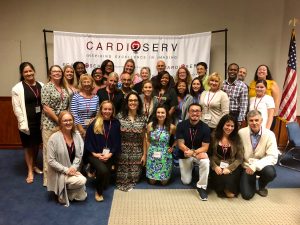
Andrea got us started with a review of degenerative mitral valve disease and how best to identify it. She also provided step by step instructions on how to perform PISA. You can review those topics here:
Next we had presentations on some of the important views required prior to a MitraClip case. We reviewed the key components of both transthoracic and transesophageal echocardiograms.
Left Heart:
Other Valvular Disease
Be sure to perform an complete echocardiogram and include the following:
We will post a future blog on tips for performing a TEE for MitraClip patients.
Next up on the agenda we held a mock valve clinic with Dr. Christina Michael and nurse practitioner Elyce Kwasman. If you haven’t checked out their spotlight articles, take a peak to learn more about both speakers. During the valve clinic we reviewed what happens behinds the scenes once a potential patient has been identified for the MitraClip procedure. Elyce reviewed the steps she takes including assessing the frailty and functionality of the patient.
We reviewed three cases to determine if they were good candidates for the MitraClip procdure. We will post these cases in future blogs.
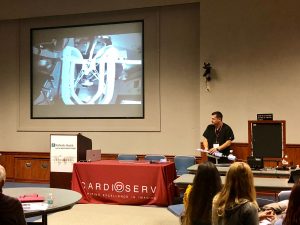
Jeff Perez, Abbott – MitraClip demonstration
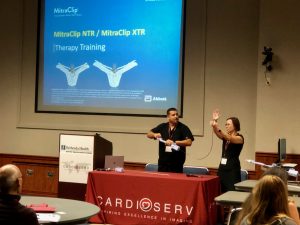
Jeff Perez, and Jennine Noel-Estkowski Abbott – MitraClip demonstration
We all enjoyed the hour training with Jeffrey Perez from Abbott. Check out his spotlight article too! Jeff was accompanied by Jennine Noel-Estkowski from Abbott, who had flown out from California. Together they demonstrated the MitraClip apparatus and how to use it. There is a great short video you can watch on Abbott’s website if you would like an idea of how the MitraClip works.
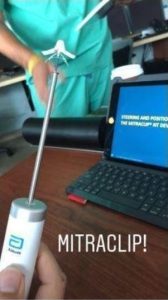
The MitraClip is a percutaneous procedure used to reduce significant MR. The indications for use include:
“Significant symptomatic mitral regurgitation (+3) due to primary abnormality of the mitral apparatus [degenerative MR] in patients who have been determined to be a prohibitive risk for mitral valve surgery by a heart team, which includes a cardiac surgeon experienced in mitral valve surgery and a cardiologist experienced in mitral valve disease, and whom existing comorbidities would not preclude the expected benefit from reduction of the mitral regurgitation” (Abbott, 2017)
Both TEE echocardiography and fluoroscopy are used during the MitraClip procedure. TEE is used to guide the clip and for observation during the procedure and Fluoroscopy is used for guidance and observation and as secondary imaging for equipment and anatomical borders (Abbott, 2017). One of the important aspects of the procedure that TEE aids with is the trans-septal puncture.
The trans-septal puncture is required for the catheters to cross through the IAS into the left atrium. This needs to occur at a specific location which is measured 4 – 5 cm from the mitral annulus in the 4 chamber TEE view. Abbott brought their heart model camera which allowed us the opportunity to see an entire demonstration of how the MitraClip is deployed. We will have future blogs that will describe in more detail the entire procedure.
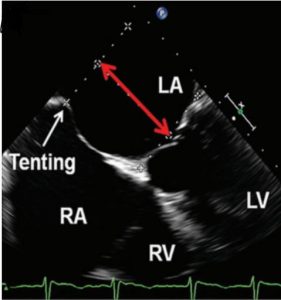
European Heart Journal – Cardiovascular Imaging (2013) 14, 941 doi:10.1093/ehjci/jet060
The final presentation was provided by Dr. Daniel. Please check out his spotlight article to learn more about his training and experience with the MitraClip procedure. Dr. Daniel presented a great case of a patient with a Barlow’s mitral valve that received two MitraClips with a significant reduction in mitral regurgitation.
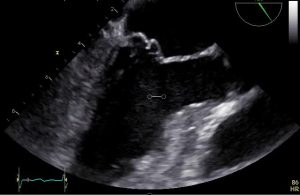
Barlow MVP – Pre MitraClip
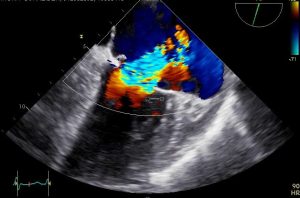
MR – Pre MitraClip
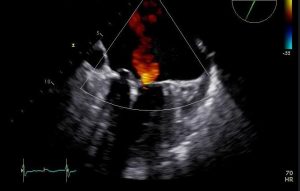
MR – Post MitraClip (2 clips deployed)
On Saturday October 20, 2018, CardioServ hosted an Echo Symposium…What the Clip! The symposium was a great success and we would like to thank all those that made it possible. We will be presenting some of the symposium contents in upcoming blogs, so keep your eyes open!
We are still trying to beat our record for the largest selfie pic!! Check out some of the other pictures from the event!
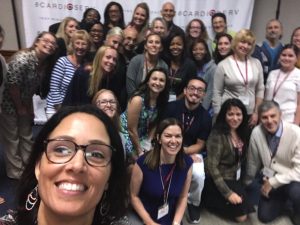
CardioServ Echo Symposium – Selfie!!
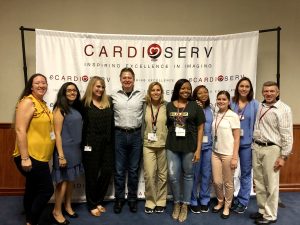
Bethesda Hospital attendees
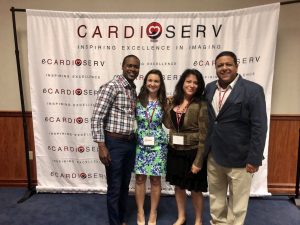
GE Staff and Attendees

Attendee’s from JFK North



